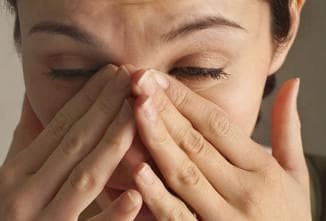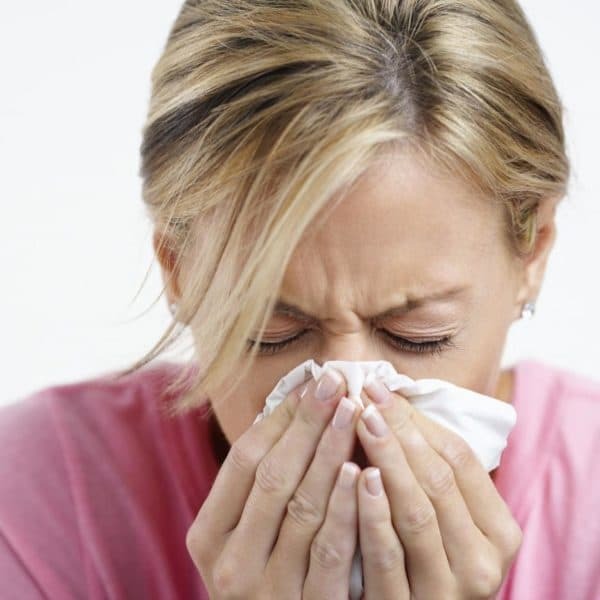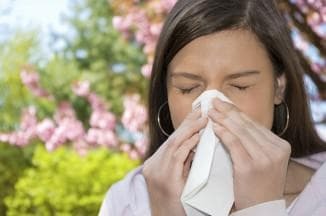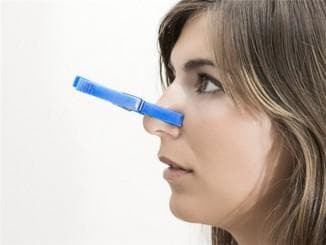
Rhinitis is one of the most common pathologies of the upper respiratory tract. If the treatment of this disease is not started in time, it can cause various complications - otitis, angina, pharyngitis, etc. Therefore, when the first symptoms of nasal congestion appear, you should immediately consult a doctor. Thanks to the correct approach to therapy, it will be possible to get rid of a protracted rhinitis.
Contents of
- 1 What is rhinitis?
- 2 Possible causes and predisposing factors
- 2.1 Weakened local immunity
- 2.2 External factors
- 3 First signs and symptoms
- 4 Diagnosis
- 5 Methods of treatment
- 5.1 Folk remedies and medications
- 6 Possible consequences and complications of the disease
- 7 Video
What is rhinitis?
Rhinitis, or runny nose, is an inflammation of the nasal cavity. Typically, this is one of the signs of a major pathology that has a viral, bacterial, immune or mechanical origin. In addition, rhinitis is acute or chronic.
As a rule, the common cold is accompanied by a burning sensation and mucous discharge from the nose. Also, this condition is characterized by dryness in the nasal cavity and partial or gender  loss of smell. Depending on the cause of the disease, doctors distinguish such varieties of rhinitis:
loss of smell. Depending on the cause of the disease, doctors distinguish such varieties of rhinitis:
- atopic;
- atrophic;
- catarrhal;
- is allergic;
- drug;
- year-round;
- chronic;
- vasomotor;
- is psychogenic.
And here's how to treat chronic rhinitis and what means should be used in the first place.
Possible causes and predisposing factors
All causes of rhinitis are divided into two main groups:
Weakening of local immunity
In this case, the cause of frequent rhinitis lies in the physiological characteristics of the body. Epithelium of the nasal cavity is covered by small cilia that expel foreign particles. In the mucosa there are protective proteins that cope with infections. With a decrease in local immunity, a pathogenic microflora is activated, which previously did not cause any harm.
External factors
 They disrupt the operation of the nasal mucosa. As a result, inflammation develops, which becomes the main cause of rhinitis. Such factors include the following:
They disrupt the operation of the nasal mucosa. As a result, inflammation develops, which becomes the main cause of rhinitis. Such factors include the following:
- local and general subcooling of - as a result, the body becomes less resistant to pathogenic microorganisms;
- traumatic nasal cavity injuries - getting foreign objects into the nose and surgical interventions increase the threat of inflammation;
- production factors - prolonged exposure to a room with a large amount of toxic substances and dust causes irritation of the nasal mucosa;
- allergy - pollen of plants, house dust, animal hair can provoke the development of allergic rhinitis.
Runny nose can be one of the symptoms of serious diseases. These include latent hypothyroidism, autoimmune pathologies, cystic fibrosis, Kartagener's syndrome.
And here is how to use a spray against allergic rhinitis and how effective this remedy is.
There are certain risk factors that significantly increase the likelihood of developing rhinitis:
- Chronic diseases. In any pathology of a chronic nature, the body's defenses are significantly reduced. Diseases such as chronic bronchitis or tonsillitis significantly increase the risk of rhinitis.
- Acute diseases in the recent past. The development of the common cold can provoke the flu or tonsillitis.
- Subcooling the body or sudden temperature changes. This risk factor is especially relevant for unskilled people.
- Incorrect food.
- Adverse environmental conditions.
- The presence of bad habits - in particular, smoking and drinking alcoholic beverages.
First signs and symptoms of

The first signs of rhinitis are dryness in the nose and burning sensation
Usually rhinitis passes through several stages of development that are characterized by certain symptoms. Thus, the first stage is characterized by the ingress of pathogenic microorganisms onto the nasal mucosa. They provoke her irritation and cause such symptoms:
- dryness in the nose;
- burning sensation;
- temperature increase to subfebrile indicators;
- headaches.
You may also be interested in learning how to treat hypertrophic rhinitis.
In most cases, the first stage lasts for several hours, although sometimes it can be observed for 1-2 days. Then the manifestations of pathology change, and the next stage begins.
The second stage is characterized by the appearance of liquid mucous discharge from the nose. At this stage, the symptoms of the disease increase, while the feeling of dryness disappears. Usually the second stage of rhinitis is characterized by nasal congestion, a violation of breathing, a decrease in smell.
Since the nasal cavity has a communication with the mucous membrane of the eyes, the pathological process can affect the conjunctiva. As a result, conjunctivitis develops, which is accompanied by lacrimation.
The next stage develops on the 4th-5th day and is characterized by the appearance of an immune response to infection by pathogenic microorganisms. At this time from the nose there are mucopurulent discharge, which have a fairly thick consistency, and sometimes a fetid odor.
Similar processes are explained by the ingress of protective cells - phagocytes and neutrophils - into the nasal mucosa. They provoke inflammation and swelling of the mucous membrane. As a result, it is possible to cope with bacteria that are present in the nasal cavity. If there are a lot of pathogens, phagocytes burst, which provokes the appearance of purulent discharge from the nose.
 After a few days, these symptoms gradually disappear, and the inflammation gradually subsides. The person regains breathing and improves the general condition. The duration of such processes is affected by many factors, the main one of which is resistance to pathogenic microorganisms.
After a few days, these symptoms gradually disappear, and the inflammation gradually subsides. The person regains breathing and improves the general condition. The duration of such processes is affected by many factors, the main one of which is resistance to pathogenic microorganisms.
In healthy people, leading an active lifestyle, rhinitis can last literally 2-3 days. If the body's immune defense is reduced, the pathology proceeds much more complicated and is accompanied by severe manifestations of intoxication - fever, headaches. In this case, the inflammation may be present for 3-4 weeks and even become chronic.
If symptoms of rhinitis appear, you should immediately contact a profile doctor who will determine the causes of this disorder. Only timely therapy will be really effective.
You may also be interested in learning how to use hormonal sprays for allergic rhinitis.
Diagnosis
 To make the correct diagnosis, the physician should rely on the symptoms characteristic of this disorder. But sometimes the differentiation of manifestations from specific rhinitis is required, which is a sign of a more serious disease. This could be influenza, whooping cough, measles, scarlet fever, etc. Each of these disorders has a characteristic clinical picture. To clarify the form and the form of the common cold, the ENT organs are examined.
To make the correct diagnosis, the physician should rely on the symptoms characteristic of this disorder. But sometimes the differentiation of manifestations from specific rhinitis is required, which is a sign of a more serious disease. This could be influenza, whooping cough, measles, scarlet fever, etc. Each of these disorders has a characteristic clinical picture. To clarify the form and the form of the common cold, the ENT organs are examined.
If a suspicion of complications arises, the doctor may order an x-ray examination of the paranasal sinuses. X-rays of the lungs and ears may be required. Sometimes it is necessary to consult a narrow specialist - pulmonologist, allergist, ophthalmologist. If the rhinitis is accompanied by a strong cough, the pharynx and larynx must be examined.
But what are the folk remedies for allergic rhinitis and how to apply them correctly, is indicated here.
Methods of treatment
The first symptoms of rhinitis are prescribed home treatment and abundant drink. In the absence of an elevated temperature, it is also possible to perform thermal procedures. It is important to learn how to blow your nose properly to clear the nasal cavity and prevent the discharge of excreta into the paranasal sinuses and the middle ear. To this end, you should alternately release each half of the nose.
In rhinitis, one should drink a lot of warm liquid. When the temperature rises, antipyretic agents may be used. With a common cold of virus origin, it is recommended to inject into the nose solutions of interferon.
And here is how to distinguish allergic rhinitis from colds and what means should be used.
It is very important to eat properly to strengthen immunity and speed up the healing process. In addition, for this purpose, doctors advise to use immunostimulants and vitamin complexes.
Folk remedies and medications

In addition to classic sprays in the nose, many other categories of medicines are used to treat rhinitis
Usually, medicines are used for rhinitis therapy:
- Vasodilators. Used to reduce edema and nasal congestion. The most effective means include sanorin, ximelin, nazole.
- Moisturizers and ointments. Salt solutions - marimer, aquamaris, physiomer - help to cleanse the nasal cavity. Ointments are usually used in the atrophic form of rhinitis and promote softening of the crusts.
- Angioprotectors. Improve microcirculation in tissues and reduce congestion in the mucosa. Effective drugs such as rutin and troxevasin are effective.
- Antihistamines. Helps in the treatment of allergic rhinitis. The doctor can prescribe cetrin, tavegil, claritin in the form of capsules or tablets.
- Antiviral drugs. Highly effective in the treatment of rhinitis of viral origin. Usually prescribed drugs such as arbidol, anaferon, oxolin ointment.
- Antibiotics. These agents are indicated exclusively for bacterial rhinitis or complications. Most often doctors prescribe bioparox.
Also for the treatment of the common cold, local antiseptics are successfully used, for example a spray in the nose of Miramistin. Of the folk remedies inhalations with decoctions of herbs are excellent. You can make baths for the feet and hands with the addition of mustard powder. An excellent effect is the juice of Kalanchoe, menthol oil, fresh juice of carrots or beets.
An effective solution is the use of a salt solution, which is prepared in the ratio of a tablespoon of salt to a liter of water. For rinsing, you can use a syringe, syringe or special device.
Many traditional medicine products are suitable for the elimination of infectious rhinitis, which is a consequence of viral pathologies. With allergic rhinitis, the use of such drugs can provoke an exacerbation. In addition, it should be remembered that many folk remedies for the treatment of sinusitis and protracted cold are suitable for the treatment of rhinitis.
Possible consequences and complications of
 disease If the rhinitis therapy is not started in time, it can cause the spread of the infection to nearby organs. As a result, there will be such complications:
disease If the rhinitis therapy is not started in time, it can cause the spread of the infection to nearby organs. As a result, there will be such complications:
- Purulent sinusitis.
- Average Otitis.
- Pharyngitis.
- Tonsillitis.
- Laryngitis.
- Tracheitis.
- Bronchitis.
The weakening of the immune system as a result of a viral infection can trigger the onset of bacterial complications. In this case, there is a development of acute pathology or exacerbation of chronic processes.
Video
The doctor-otolaryngologist tells how to distinguish rhinitis from other diseases:
Rhinitis in adults can develop under the influence of various factors. If symptoms of this disorder appear, consult a doctor. Thanks to adequate treatment, it is possible to quickly cope with this unpleasant phenomenon and prevent the development of complications.
